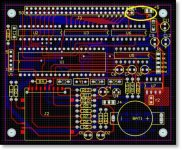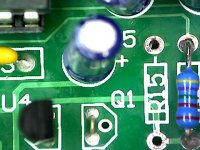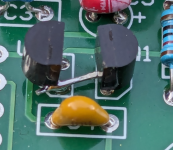Kevin Williams
Experienced Member
Hi Everyone,
Well, I'm stumped, and I was hoping someone might be able to point me in the right direction. I bought three Kit B FreHD's about 1.5 years ago and built them all out. One worked right away, and another worked with a little SD card soldering fixes. The third however, never would behave. I tried swapping parts around on one of the good and bad ones, and accidentally installed the PIC backwards. After that, only one was working! I figured I had killed the GAL or PIC, so I wound up shelving them and then I sold the one working one with a Model 4P.
When I bough the FreHD's I got the GAL & PIC preprogrammed, and I now have a Vstager VS4000 programmer which will program Lattice Gal's and 18F4620's. Well the 4620's are not too happy in this guy. Out of 11, I have two which seem to succeed. It really seems to have a problem writing the EEPROM. I wound up putting 3 10k resistors on the programmer to pull signal lines a little tighter, and it actually started to work. Before, it would fail to verify in the program code on nearly all of them, with the resistors, it fails on the eeprom on 9 of them, and 2 succeed. (Seems like the erase may be failing to wipe the EEPROM, it shows all 0x00's) Fred Vecoven was kind enough to send me the debug hex for 2.14, and I installed that on one of my good chips, and watched the serial port. On both boards, it shows the file system mounting just fine. To me, this means the PIC, SD, RTC, etc are all good on the boards. This leaves the GAL, the 245 & the 595.
I have an IC tester, and all of my ICs are TI, new and test good. I tried LS, F, HC & HCT variants of all chips in multiple combos. I'm testing on both a FreHD eprom'd model III & 4(non gate array gen-2). I even went back to the original ROM, and tried the boot disks. They just hang. VHDUTL show no interface available.
My programmer acts like it succeeds on the GAL with no issue, and it takes less than 2 seconds to program. The verify works just fine too, so it seems to be ok, but maybe not? Maybe the PICs are not working right? (I bought the PICs from Mouser, and the GALs from eBay, they seem to be discontinued now.)
I'm at a loss now. I feel like I've tried everything that makes sense, and I feel like I've isolated down to the interface itself. As such, is there a better programmer for me to try for the GAL? I would think I made a mistake on the board somewhere, but I have two acting exactly the same, and honestly, one of these guys worked before at some point. I had to have killed the PIC or GAL to make it start failing, but I have all new ones now. All of the ICs are new on them now to be honest.
I appreciate any guidance this group can provide! I'm really anxious to figure out where the issue lies.
Take care,
-Kevin
Well, I'm stumped, and I was hoping someone might be able to point me in the right direction. I bought three Kit B FreHD's about 1.5 years ago and built them all out. One worked right away, and another worked with a little SD card soldering fixes. The third however, never would behave. I tried swapping parts around on one of the good and bad ones, and accidentally installed the PIC backwards. After that, only one was working! I figured I had killed the GAL or PIC, so I wound up shelving them and then I sold the one working one with a Model 4P.
When I bough the FreHD's I got the GAL & PIC preprogrammed, and I now have a Vstager VS4000 programmer which will program Lattice Gal's and 18F4620's. Well the 4620's are not too happy in this guy. Out of 11, I have two which seem to succeed. It really seems to have a problem writing the EEPROM. I wound up putting 3 10k resistors on the programmer to pull signal lines a little tighter, and it actually started to work. Before, it would fail to verify in the program code on nearly all of them, with the resistors, it fails on the eeprom on 9 of them, and 2 succeed. (Seems like the erase may be failing to wipe the EEPROM, it shows all 0x00's) Fred Vecoven was kind enough to send me the debug hex for 2.14, and I installed that on one of my good chips, and watched the serial port. On both boards, it shows the file system mounting just fine. To me, this means the PIC, SD, RTC, etc are all good on the boards. This leaves the GAL, the 245 & the 595.
I have an IC tester, and all of my ICs are TI, new and test good. I tried LS, F, HC & HCT variants of all chips in multiple combos. I'm testing on both a FreHD eprom'd model III & 4(non gate array gen-2). I even went back to the original ROM, and tried the boot disks. They just hang. VHDUTL show no interface available.
My programmer acts like it succeeds on the GAL with no issue, and it takes less than 2 seconds to program. The verify works just fine too, so it seems to be ok, but maybe not? Maybe the PICs are not working right? (I bought the PICs from Mouser, and the GALs from eBay, they seem to be discontinued now.)
I'm at a loss now. I feel like I've tried everything that makes sense, and I feel like I've isolated down to the interface itself. As such, is there a better programmer for me to try for the GAL? I would think I made a mistake on the board somewhere, but I have two acting exactly the same, and honestly, one of these guys worked before at some point. I had to have killed the PIC or GAL to make it start failing, but I have all new ones now. All of the ICs are new on them now to be honest.
I appreciate any guidance this group can provide! I'm really anxious to figure out where the issue lies.
Take care,
-Kevin





